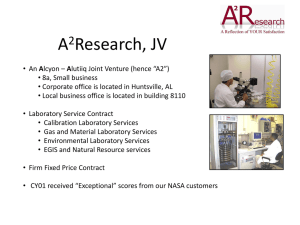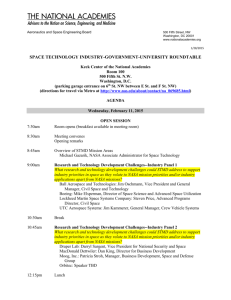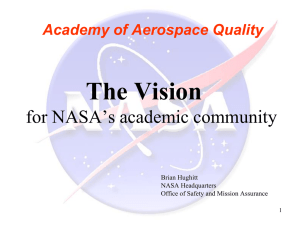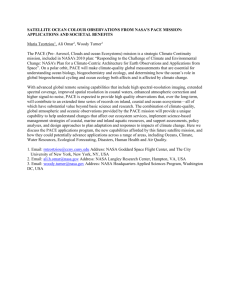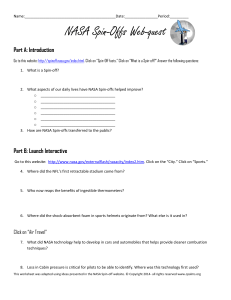Skylan Aff NASA
advertisement
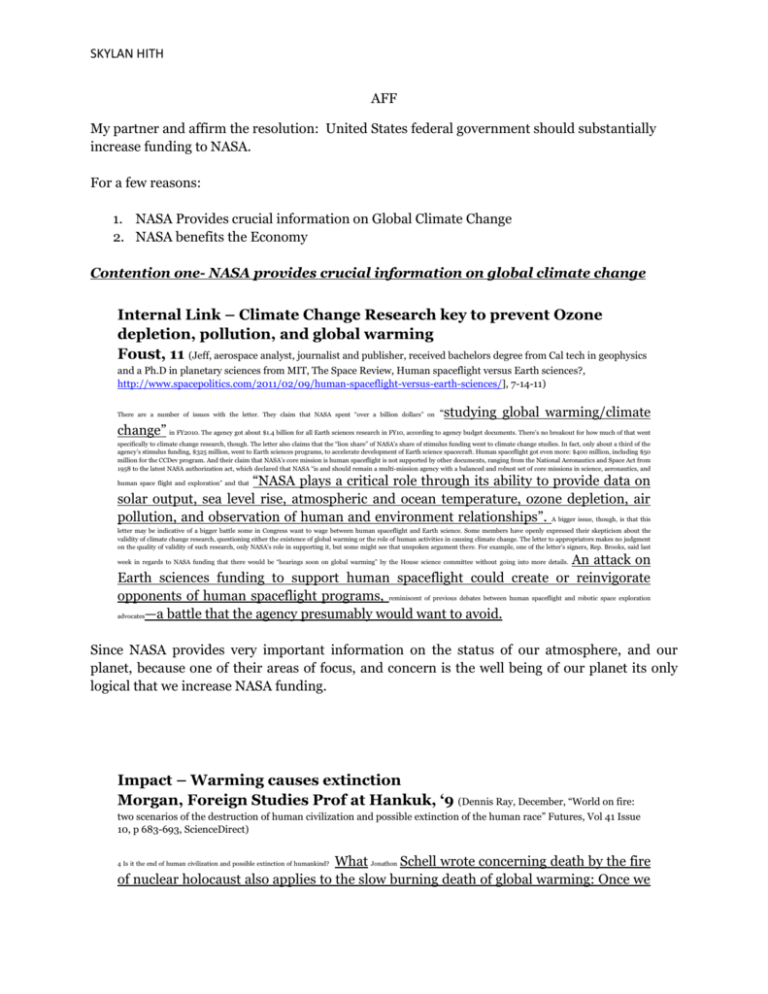
SKYLAN HITH AFF My partner and affirm the resolution: United States federal government should substantially increase funding to NASA. For a few reasons: 1. NASA Provides crucial information on Global Climate Change 2. NASA benefits the Economy Contention one- NASA provides crucial information on global climate change Internal Link – Climate Change Research key to prevent Ozone depletion, pollution, and global warming Foust, 11 (Jeff, aerospace analyst, journalist and publisher, received bachelors degree from Cal tech in geophysics and a Ph.D in planetary sciences from MIT, The Space Review, Human spaceflight versus Earth sciences?, http://www.spacepolitics.com/2011/02/09/human-spaceflight-versus-earth-sciences/], 7-14-11) “studying global warming/climate change” in FY2010. The agency got about $1.4 billion for all Earth sciences research in FY10, according to agency budget documents. There’s no breakout for how much of that went There are a number of issues with the letter. They claim that NASA spent “over a billion dollars” on specifically to climate change research, though. The letter also claims that the “lion share” of NASA’s share of stimulus funding went to climate change studies. In fact, only about a third of the agency’s stimulus funding, $325 million, went to Earth sciences programs, to accelerate development of Earth science spacecraft. Human spaceflight got even more: $400 million, including $50 million for the CCDev program. And their claim that NASA’s core mission is human spaceflight is not supported by other documents, ranging from the National Aeronautics and Space Act from 1958 to the latest NASA authorization act, which declared that NASA “is and should remain a multi-mission agency with a balanced and robust set of core missions in science, aeronautics, and “NASA plays a critical role through its ability to provide data on solar output, sea level rise, atmospheric and ocean temperature, ozone depletion, air pollution, and observation of human and environment relationships”. A bigger issue, though, is that this human space flight and exploration” and that letter may be indicative of a bigger battle some in Congress want to wage between human spaceflight and Earth science. Some members have openly expressed their skepticism about the validity of climate change research, questioning either the existence of global warming or the role of human activities in causing climate change. The letter to appropriators makes no judgment on the quality of validity of such research, only NASA’s role in supporting it, but some might see that unspoken argument there. For example, one of the letter’s signers, Rep. Brooks, said last An attack on Earth sciences funding to support human spaceflight could create or reinvigorate opponents of human spaceflight programs, reminiscent of previous debates between human spaceflight and robotic space exploration advocates—a battle that the agency presumably would want to avoid. week in regards to NASA funding that there would be “hearings soon on global warming” by the House science committee without going into more details. Since NASA provides very important information on the status of our atmosphere, and our planet, because one of their areas of focus, and concern is the well being of our planet its only logical that we increase NASA funding. Impact – Warming causes extinction Morgan, Foreign Studies Prof at Hankuk, ‘9 (Dennis Ray, December, “World on fire: two scenarios of the destruction of human civilization and possible extinction of the human race” Futures, Vol 41 Issue 10, p 683-693, ScienceDirect) What Jonathon Schell wrote concerning death by the fire of nuclear holocaust also applies to the slow burning death of global warming: Once we 4 Is it the end of human civilization and possible extinction of humankind? SKYLAN HITH learn that a holocaust might lead to extinction, we have no right to gamble, because if we lose, the game will be over, and neither we nor anyone else will ever get another chance. Therefore, although, scientifically speaking, there is all the difference in the world between the mere possibility that a holocaust will bring about extinction and the certainty of it, morally they are the same, and we have no choice but to address the issue beyond the horror of nuclear war, another horror is set into motion to interact with the subsequent nuclear winter to produce a poisonous and super heated planet , the chances of human survival seem even smaller. Who knows, even if some small remnant does manage to survive, what the poisonous environmental conditions would have on human evolution in the future. A remnant of mutated, subhuman creatures might survive such harsh conditions, but for all purposes, human civilization has been destroyed, and the question concerning human extinction becomes moot. of nuclear weapons as though we knew for a certainty that their use would put an end to our species [23].15 When we consider that By increasing our funding to NASA we increasing our abilities to know about the detrimental impacts of global warming. With out its satellites we would be in the dark on many areas of the happenings on our earth. NASA also spends high percentages of its budget on earth science. Science is being funded now PRWeb 6/20 (http://www.sfgate.com/cgi-bin/article.cgi?f=/g/a/2011/06/20/prweb8584611.DTL) Grants Pass, OR (PRWEB) June 20, 2011 San Francisco Chronicle The 2011 NASA budget is up slightly at $18.7 billion, from 2010. 26.3% of NASA's budget ($5 billion) is in the "Science" category. "Science" includes Astrophysics, Earth Science (36% of the Science budget), Heliophysics, James Webb Space Telescope and Planetary Science. The Science budget slightly exceeds the Space Operations budget (25.4%) Space Operations has been cut drastically ($6.1 NASA budget highlights: billion to $4.3 billion), due to ending the Space Shuttle program. However, Space Technology has been increased ($275 million to $1.1 billion). 2011 NASA Budget Information (advances in Earth science) http://www.nasa.gov/news/budget/index.html NASA's Earth Science Theme advances knowledge of the integrated Earth system, the global atmosphere, oceans (including sea ice), land surfaces, ecosystems, and interactions between all elements, including the impacts of humans. Sustained, simultaneous observations of many quantities are needed to unravel the complexity of the global Earth system. Maintaining balance continues to be a hallmark of NASA's Earth Science Theme: Flight Programs develop satellite missions and provide observations; Research redeems the investment in flight by analyses to increase scientific understanding and identify the foci for future missions; Technology develops new measurement approaches; and Applied Sciences provides direct societal benefit by advancing the use of Earth science measurements and scientific understanding to undergird environmental policy decisions. NASA aircraft and surface instruments calibrate, complement, and expand the value of satellite measurements. NASA supports computing . NASA missions produce nearly 4 terabytes of data daily, and NASA maintains the world's largest scientific data and information system for processing, archiving, and distributing Earth system data to worldwide users. International collaborations including collaborative space missions, joint research capability and capacity for Earth system modeling efforts, and information/education programs such as Global Learning and Observations to Benefit the Environment (GLOBE) and SERVIR are essential for the Earth Science Theme. SKYLAN HITH NO Tradeoff, Obama is dedicated to combating Global Warming though NASA Rory Cooper January 27, 2010 Director of Strategic Communications at The Heritage Foundation. Obama Is No Kennedy: Redefines NASA’s Mission As Global Warming http://blog.heritage.org/2010/01/27/obama-is-no-kennedy-redefines-nasas-mission-asglobal-warming/ President Obama will introduce a budget next week which will cut future exploration funding from NASA, including the planned missions to the Moon and Mars set in motion following the Columbia disaster. On first glance, this may appear to be a budget cutting move to fall in line with the drop-ina-bucket spending freeze Obama has proposed. But it isn’t. In fact, NASA’s budget is increasing. So if NASA’s budget is increasing, why are exploration plans being put on hold? Obama is halting America’s exploration of the unknown so we can explore…global warming. According the Sentinel: “…the White House will direct NASA to concentrate on Earth-science projects — principally, researching and monitoring climate change.” NASA will reportedly receive a budget increase of $200-$300 million over its current $18.7 billion budget. But for the first time in his administration, government money does not actually equate to government jobs. Today, the Orlando Sentinel reports that “One administration official said the budget will send a message that it’s time members of Congress recognize that NASA can’t design space programs to create jobs in their districts. ‘That’s the view of the president,’ the official said.” So this is actually a jobs-cutting outlay. President Obama spent the better part of 2009 growing the size of government despite record job losses in the private sector. While unemployment rose above 10%, the number of federal, state and local government union employees rose by 64,000 in 2009. The view of the President, as demonstrated by his actions, is that the government is precisely designed to create jobs in member’s districts. So is the real reason for this shift in focus? The real reason is that liberals have long viewed NASA as a global warming research entity rather than the exploration agency that President John F. Kennedy ably set on a course for the stars. And this is despite the recent discoveries that NASA’s global warming leaders, such as James Hansen, may have been manipulating data to suit their political needs for some time. While exploration enthusiasts wanted to see rockets lift for the heavens, environmentalists wanted to see satellites watching ice caps. President Obama will most likely face stiff congressional opposition from both sides of the aisle if he continues on this path towards charging NASA with a purely Earth science mission. Contention two- NASA Benefits the economy. NASA Ames Stimulates Economy with Jobs, Innovation Karen Hanner, Ames Research Center, Moffett Field, CA, May 10, 2010 NASA’s Ames Research Center generated 5,300 jobs and $877 million in total annual economic activity in the nine-county San Francisco Bay Area in 2009, according to a new economic benefits study. MOFFETT FIELD -- NASA Ames supports more than 8,400 jobs and generates $1.3 billion in annual economic activity. Coordinated by the NASA Research Park Office and prepared by Emeryville-based Bay Area Economics (BAE) in association with Architecture, Engineering, Consulting, Operations and Management’s San Francisco office, the study also reported that NASA Ames produced 5,900 jobs and contributed $932 million to California’s economy in 2009. The study also forecast that NASA Ames’ total economic impacts will grow significantly as its NASA Research Park (NRP) is completed. The study found that nationally, “As Ames explores space and our planet, it stimulates economic growth by employing SKYLAN HITH scientists and engineering professionals, promoting technology innovation, and preparing the workforce of the future — all to enhance the health, growth, and long-term competitiveness of the Bay Area and the nation,” said Ames Director S. Pete Worden. Currently host to more than 70 on-site industry, university and non-profit partners, NRP will ultimately comprise 5.7 million square feet of new construction for research and development offices, university classrooms and laboratories, rental housing, museums, and a conference and education center. New construction at NRP is expected to total approximately $2.8 billion, generating an average of 1,700 construction jobs annually over the next 15 years in the Bay Area, 1,900 in California, and more than 2,800 nationally. “With the unemployment rate in the Bay Area for construction workers at 30 per cent, the development of the NASA Research Park may create thousands of jobs that will help put people to work and stimulate the local economy. It is these types of projects that create a triple bottom line: higher education, economic development and good jobs,” said Neil Struthers, chief executive officer of the Santa Clara and San Benito Building and Construction Trades Council. Upon full occupancy, NRP partners may further stimulate the local, state, and national economy with new jobs and economic activity. Bay Area Economics estimated that NRP would trigger $4 billion in new annual economic activity resulting in an additional 21,400 jobs in the Bay Area region. The study also predicted that nationally, NRP will contribute $5.8 billion in new annual economic activity and 33,800 new permanent jobs. The NRP was developed in partnership with the neighboring cities of Mountain View and Sunnyvale. “For many years the City of Mountain View and NASA Ames have enjoyed a close partnership. This Economic Benefits Study quantifies Ames’, and particularly the Research Park’s, employment and economic output contribution to our region, and the city looks forward to continuing this partnership to enhance these benefits for our community,” said Mountain View City Manager Kevin C. Duggan. The study concluded that NASA Ames also plays a critical role in supporting the nation’s drive to promoting future economic growth. NASA Ames has forged numerous partnerships with private industry, educational institutions, and nonprofit organizations that have contributed to breakthroughs in climate change research, disaster response capacity, and commercialization of space, robotics, supercomputing, nanotechnology, small satellites, and green/clean technology. "NASA Ames fuels innovation through exploration that creates jobs and helps power the Silicon Valley economy," said Silicon Valley Leadership Group Chief Executive Officer Carl Guardino. "This is but one more stellar example of NASA Ames' contributions to our region, state and nation." NASA is working to educate the next generation of scientists, engineers, and technical professionals, and operates a comprehensive set of educational programs that teach students and train teachers in science, technology, engineering and math. The NRP’s educational partners include the University of California Santa Cruz, Carnegie Mellon University, Santa Clara University, Foothill / De Anza Community College, United Negro College Fund Special Programs Corporation, and Singularity University. “In addition to the NRP research and development collaborations, we are developing more formal multi-party relationships, including science, technology, engineering and math education and regional disaster assistance, with the fundamental premise of leveraging all parties’ expertise, facilities and resources to accomplish more than we can as individual organizations,” said NRP Director Michael Marlaire. NASA Ames Research Center is one of 10 NASA centers with an annual budget of approximately $750 million and more than 2,500 onsite civil servant and contractor employees. NASA Ames is located on approximately 2,000 acres adjacent to the cities of Mountain View and Sunnyvale in California’s Silicon Valley. NASA Ames conducts scientific research and research and development in the fields of astrobiology; Earth and life sciences; artificial intelligence; information technology; supercomputing; airspace systems; entry, descent, and landing systems; and small satellites and related technologies. According to Alastair Endersby, Friday, June 04, 2010 (Database Editor) (United Kingdom) Alastair is the Editor of Database. In this topic he has developed an original topic idea contributed by Bryan Vetter of the USA. Cutting NASA out of the federal budget, would only cut less than one percent of the total. Compare this to the 5% of the federal budget spent on NASA at the height of the Apollo missions to the moon and it is clear that its current programs are affordable. Nor would scrapping NASA and spending its budget on social programs make any great difference – the federal government alone spends nearly a hundred times more on social programs than it does on NASA (and state and local governments spend tens of billions more tax dollars on similar programs). So the impact on the poor from redirecting our space exploration budget would be less significant than a rounding error in federal accounting. By comparison, defense and homeland security spending is more than forty times NASA’s budget each year, so if the nation is to change its priorities that is clearly a better place to start. We are spending such a small portion of our National Budget into NASA, and its information is very valuable and that’s why we should spend even more into its successful programs. We have shown you how much effort and money already goes into earth science, this is very important information that allows us to take action on things like global warming. And because it isn’t taking away any sort of major amount of money from our country this is something that must be invested in.


